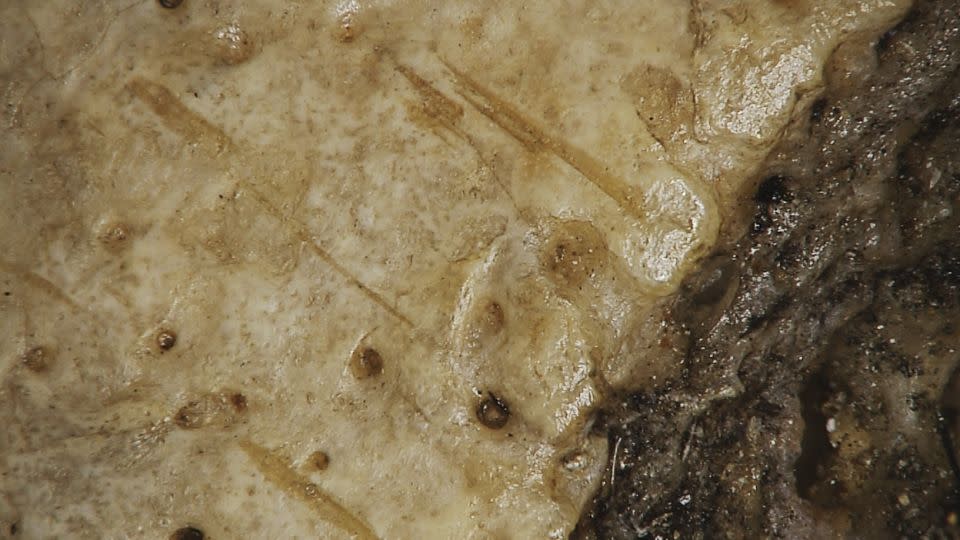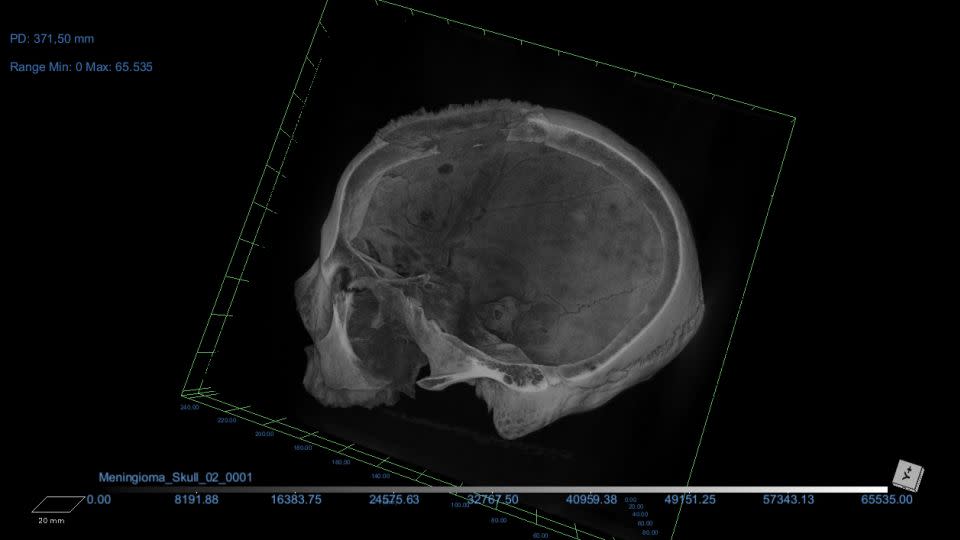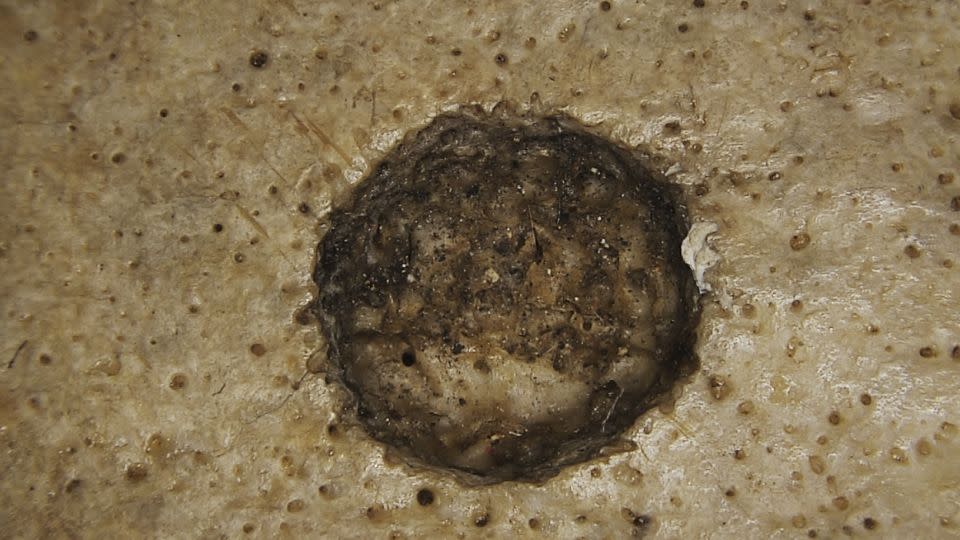Sign up for CNN’s Wonder Theory science newsletter. Explore the universe with news about fascinating discoveries, scientific developments and more.
Cancer is often seen as a disease of the modern age. However, medical texts from ancient Egypt indicate that healers of the time were aware of the condition. Now, new evidence from a skull more than 4,000 years old has revealed that ancient Egyptian doctors may have tried to treat certain cancers with surgery.
The skull belonged to a man who was approximately 30 to 35 years old when he died, and is in the Duckworth Laboratory collection at the University of Cambridge in the United Kingdom. Since the mid-19th century, scientists have studied the scarred surface of the skull, which included multiple lesions thought to represent bone damage from malignant tumors. Archaeologists consider the skull, number 236 in the collection, to be one of the oldest examples of malevolence in the ancient world, dating back to between 2686 BC and 2345 BC.
But when researchers recently took a closer look at the tumor scars with a digital microscope and micro-computed tomography (CT) scans, they discovered signs of lacerations around the tumors, suggesting that sharp metal instruments had been used to remove the growths. The scientists reported the findings on Wednesday in the journal Frontiers in Medicine.
“It was the very first time humanity had to surgically deal with what we now call cancer,” said senior study author Dr. Edgard Camarós, professor of history at the University of Santiago de Compostela in Coruña, Spain.
However, it is unknown whether the healers attempted to remove the tumors while the patient was alive, or whether the tumors were removed after death, for analysis, Camarós told CNN.
“If those cuts were made while that person was alive, we are talking about a treatment directly related to the cancer,” he said. But if the cut marks were made posthumously, “that means this is a medical autopsy examination related to that cancer.”
Regardless, “it’s amazing to think that they performed a surgical procedure,” Camarós added. “But we cannot actually distinguish between treatment and an autopsy.”

Medical ‘knowledge and mastery’
Medicine in ancient Egypt, extensively documented in medical texts such as the Ebers Papyrus and the Kahun Papyrus, was undoubtedly advanced, and the new findings provide important, direct evidence of this knowledge, said Dr. Ibrahem Badr, associate professor at the Department of Restoration and Conservation of Antiquities at Misr University of Science and Technology in Giza, Egypt.
“We can see that ancient Egyptian medicine was not based exclusively on herbal medicines, like medicine in other ancient civilizations,” said Badr, who was not involved in the new research. “It was directly dependent on surgical practices.”
But while this ancient evidence was well studied in the 19th and 20th centuries, 21st century technologies like those used in the new study are revealing previously unknown details about the medical arts of ancient Egypt, Badr added.
“The research provides a new and solid direction for reevaluating the history of medicine and pathology among the ancient Egyptians,” he said. The study authors’ methods “transfer their results from the realm of uncertainty and archaeological possibility to the realm of scientific and medical certainty.”
The scientists also found cancerous lesions in a second skull from the Duckworth collection. Labeled E270 and dated 664 BC. until 343 BC, it was owned by an adult woman who was at least 50 years old. The team identified three lesions on the sample where malignant tumors had damaged the bone.


Unlike skull 236, E270 showed no signs of surgery associated with the disease. But the woman’s skull contained long-healed fractures, demonstrating the success of previous medical interventions for head injuries.
“That person survived for many years after that trauma,” Camarós said.
Writing the ‘biography’ of cancer
The analysis of both skulls “is a remarkable study that provides new and clear scientific evidence on the field of pathology and the development of medicine among the ancient Egyptians,” Badr said.
Badr, who works with scientists from Europe and the United States to study atherosclerosis (plaque buildup in the artery walls) in ancient Egyptian mummies, explained that his work follows the same scientific direction as skull research. By conducting detailed examinations of mummies using 21st century technologies such as CT scans and DNA sequencing, Badr and his colleagues hope to further elucidate the extent of medical knowledge in ancient Egypt.
“There is an urgent need to re-evaluate the history of Egyptian medicine using these scientific methodologies,” Badr said. “By using these modern techniques, we will be able to study medicine in ancient Egypt and gain a more comprehensive and accurate understanding.”
The new findings also help complete part of cancer’s “dark biography” by adding a chapter written thousands of years ago, Camarós added.
“The more we look at our past, the more we know that cancer is much more common, much more present than we thought,” he said.
A medical milestone
The perception of cancer in the ancient Egyptians centered around the visible tumors that the disease caused. The earliest record of cancer is in an ancient Egyptian medical text known as the Edwin Smith Surgical Papyrus, which dates from approximately 3000 BC to 2500 BC. This text contains 48 case studies on various conditions, including one description of breast cancer.


While healers in ancient Egypt may have been aware of cancer, treating it was a different story. Most of the medical cases in the Edwin Smith papyrus mentioned medications or healing strategies. But there was nothing for the breast cancer patient’s tumors, Camarós said.
“It specifically says there is no treatment,” he said. “They realized this was a limit when it came to their medical knowledge.”
However, the incisions around the skull tumors suggest that healers in ancient Egypt attempted to change that by surgically removing the tumors to cure the patient, or to examine the tumors more closely.
“We have these two possibilities: in a way that they tried to treat it, or in a way that they tried to understand it medically, in terms of likely treatment in the future,” Camarós said. “I think this is a milestone in the history of medicine.”
Mindy Weisberger is a science writer and media producer whose work has appeared in the magazines LiveScience, Scientific American, and How It Works.
For more CNN news and newsletters, create an account at CNN.com